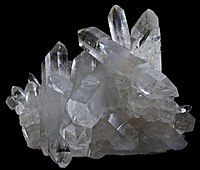
Photo from wikipedia
Nano Zero-Valent Iron (nZVI) is a versatile nanomaterial that can not only efficiently remove contaminants in soil, but also improve the soil’s geotechnical strength by changing their physicochemical properties. Inert… Click to show full abstract
Nano Zero-Valent Iron (nZVI) is a versatile nanomaterial that can not only efficiently remove contaminants in soil, but also improve the soil’s geotechnical strength by changing their physicochemical properties. Inert solid mineral particles are the most common ingredients in soils, they present universal surface modification after the nZVI treatment. This study presents an investigation on the morphological and mineral features of nZVI induced iron mineral precipitations on quartz particles. Lead was employed as the artificial contaminant, while quartz was used to mimic the inert solid mineral particles in soil. Scanning Electron Microscope (SEM), Digital Image Analysis (DIA), Transmission Electron Microscopy (TEM), laser particle size analyzer, X-ray diffraction (XRD) and Raman spectrum were carried out for the characterization. The results indicate that iron minerals precipitated heterogeneously on the surface of quartz particles with plush-like and flake-like structure. They are made of deuterogenic plumbiferous minerals and ferriferous minerals. XRD analysis demonstrated that these minerals are amorphous. The curly flake-like mineral clusters were scatteredly distributed on the surface of quartz along with the of corroded nZVI aggregation. The thickness of the curly flake-like precipitation varied from 20 nm to 60 nm, and 20 nm to 35 nm for the plush-like precipitation. The generation of these iron mineral precipitations led to a slight increase in the average particle size and a decrease in the surface area of the soil. However, no clear difference in the shape and roughness of quartz was found after the nZVI treatment. This study is provided to improve the understanding of mass transfer from nZVI to inert solid particles in soil and its effect in soil improvement.
Journal Title: Environmental geotechnics
Year Published: 2020
Link to full text (if available)
Share on Social Media: Sign Up to like & get
recommendations!